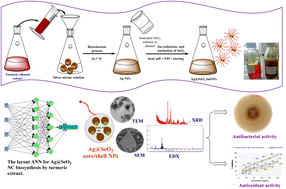Turmeric extract-mediated biogenic synthesis of Ag@SeO2 magnetic nanoparticles: characterization, optimization, antibacterial and antioxidant activities†
Abstract
This study bio-synthesized Ag@SeO2 bmNPs successfully, using turmeric ethanol extract, and characterized them using various techniques. The FT-IR analysis reveals the involvement of these plant-derived compounds, especially phenolics, in the reduction process by acting as electron donors and stabilizing/capping agents. Zeta potential analysis showed a slight negative surface charge for the stability of Ag@SeO2 NPs, where TEM revealed spherical nanoparticles with an average size of 20 nm. The XRD confirmed crystallinity and a core–shell structure, and EDX identified elements consistent with Ag@SeO2 and a 3 : 1 Ag/Se atomic ratio. Further, SEM supported the spherical shape and uniform size. These findings highlight the successful biosynthesis of Ag@SeO2 bmNPs with promising properties for diverse applications. Moreover, the Box–Behnken design (BBD) and artificial neural network (ANN) model were engaged to optimize Ag@SeO2 bmNP biosynthesis. BBD identified significant influences of pH, bioconversion temperature, time, and turmeric concentration on bmNP yield, with adjusted R2 and predictive R2 being 0.9075 and 0.8829, respectively. However, its limitations were revealed by a significant lack of fit. ANN modeling with a 3–5–7–1 topology showed superior predictive accuracy and identified optimal conditions for maximizing yield (pH 9.83, 51.7 °C, 1.0 h, 3.71 mg mL−1 turmeric). Validation experiments confirmed the model's reliability. Turmeric extract exhibited significantly higher amounts of phenolics, and flavonoids compared to the bmNPs, suggesting its potential for strong antioxidant activity. Both turmeric extract and bmNPs displayed antioxidant activity in ABTS and DPPH assays, with turmeric extract being the most potent due to its curcuminoid content. The potential activity of Ag@SeO2 bmNPs against S. aureus, K. pneumonia, E. coli, and B. cereus was investigated, with inhibition zones ranging from 22 to 32 mm. The MIC values of tested NPs towards pathogenic bacteria ranged from 165.625 and 331.25 μg mL−1.



 Please wait while we load your content...
Please wait while we load your content...